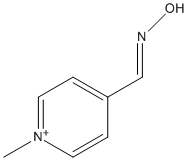4-PAM
General
Chemical_Nomenclature : (1-methylpyridin-4-ylidene)methyl-oxoazanium
Canonical SMILES : C[n+]1ccc(C=NO)cc1
InChI : InChI=1S\/C7H8N2O\/c1-9-4-2-7(3-5-9)6-8-10\/h2-6H,1H3\/p+1
InChIKey : RYQHXWDFNMMYSD-UHFFFAOYSA-O
Other name(s) : Pyridine-4-aldoxime, 4-pyridine aldoxime, 4-PA, AC1NTCBQ, CHEMBL349682, SCHEMBL14429827, MolPort-023-292-413, STL371159
MW : 137.15
Formula : C7H9N2O
CAS_number :
CID PubChem :
InChIKey UniChem :
Iuphar :
Wikipedia :

Target
Structure : No structure
Families : No family
References
No reference